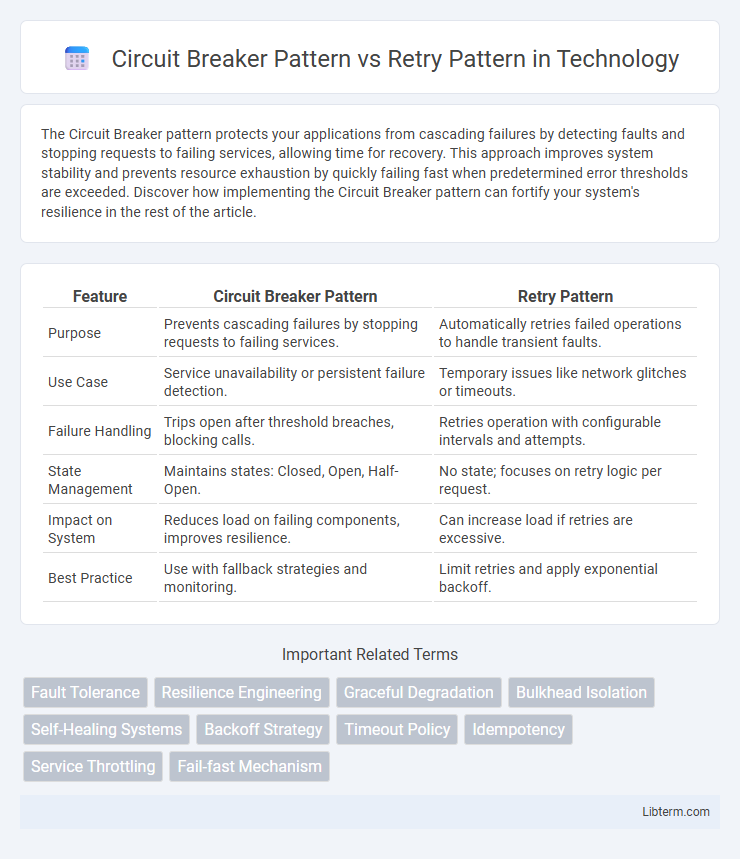The Circuit Breaker pattern protects your applications from cascading failures by detecting faults and stopping requests to failing services, allowing time for recovery. This approach improves system stability and prevents resource exhaustion by quickly failing fast when predetermined error thresholds are exceeded. Discover how implementing the Circuit Breaker pattern can fortify your system's resilience in the rest of the article.
Table of Comparison
| Feature | Circuit Breaker Pattern | Retry Pattern |
|---|---|---|
| Purpose | Prevents cascading failures by stopping requests to failing services. | Automatically retries failed operations to handle transient faults. |
| Use Case | Service unavailability or persistent failure detection. | Temporary issues like network glitches or timeouts. |
| Failure Handling | Trips open after threshold breaches, blocking calls. | Retries operation with configurable intervals and attempts. |
| State Management | Maintains states: Closed, Open, Half-Open. | No state; focuses on retry logic per request. |
| Impact on System | Reduces load on failing components, improves resilience. | Can increase load if retries are excessive. |
| Best Practice | Use with fallback strategies and monitoring. | Limit retries and apply exponential backoff. |
Introduction to Circuit Breaker and Retry Patterns
The Circuit Breaker pattern prevents system overload by monitoring service calls and temporarily halting requests when failures exceed a threshold, improving application stability and fault tolerance. The Retry pattern automatically reattempts failed operations a specified number of times with configurable delays, enhancing resilience in transient fault scenarios. Both patterns are essential for managing service reliability in distributed systems and microservices architectures.
What is the Circuit Breaker Pattern?
The Circuit Breaker Pattern is a design strategy used in software architecture to detect failures and encapsulate the logic of preventing repeated attempts to execute an operation likely to fail, thereby maintaining system stability. It functions by monitoring a service or resource; once the number of failures reaches a threshold, the circuit "opens" to block further calls, allowing the system time to recover. This pattern protects distributed systems from cascading failures and improves overall resilience by controlling error propagation and enabling graceful degradation.
What is the Retry Pattern?
The Retry Pattern is a fault-tolerance strategy used in software systems to automatically attempt an operation again after a failure, typically with configurable intervals and a maximum number of retries. It helps to handle transient errors such as network timeouts or temporary service unavailability by increasing the chances of successful execution without immediate failure. This pattern improves system resilience by reducing the impact of intermittent issues but requires careful configuration to avoid cascading failures or resource exhaustion.
Key Differences Between Circuit Breaker and Retry Patterns
The Circuit Breaker pattern prevents system overload by stopping requests to a failing service after a threshold, while the Retry pattern attempts to resend failed requests a specified number of times before giving up. Circuit Breaker maintains system stability by monitoring failure rates and opening the circuit to block requests temporarily, contrasting with Retry's focus on overcoming transient errors through repeated attempts. Circuit Breaker manages fault tolerance with state transitions (closed, open, half-open), whereas Retry emphasizes timing intervals and maximum retry counts to handle failures.
When to Use Circuit Breaker Pattern
The Circuit Breaker Pattern is essential for preventing system overload and cascading failures in distributed systems by halting calls to a failing service after a threshold of errors is reached. Use this pattern when service instability is intermittent or prolonged, and immediate retries could worsen the failure or degrade user experience. It effectively protects downstream services and maintains system resilience by temporarily blocking requests until the external service recovers.
When to Use Retry Pattern
Use the Retry Pattern when transient faults or temporary failures, such as network timeouts or service unavailability, are expected and likely to resolve quickly upon subsequent attempts. This pattern helps improve system resilience by automatically retrying failed operations a predefined number of times with configurable intervals. It is ideal for operations where latency is acceptable, and immediate failure is less critical than successful completion.
Circuit Breaker vs Retry: Performance Considerations
The Circuit Breaker pattern improves system resilience by preventing excessive retries that can overwhelm resources during failures, whereas the Retry pattern repeatedly attempts operations, potentially causing increased latency and resource exhaustion. Circuit Breakers quickly detect failures and stop calls to a failing service, enhancing performance under stress by avoiding futile retries. In contrast, retries can increase response times and degrade throughput if failures persist, making Circuit Breakers more efficient for preventing cascading failures in distributed systems.
Error Handling Strategies in Both Patterns
The Circuit Breaker Pattern prevents system overload by halting requests to a failing service, minimizing error propagation and enabling graceful recovery after failures. The Retry Pattern attempts to handle transient errors by resubmitting failed requests a specified number of times, improving resilience but risking increased latency or cascading failures if not managed properly. Both strategies address fault tolerance, with Circuit Breaker focusing on error isolation and state management, while Retry emphasizes repeated execution and delay strategies to overcome temporary faults.
Real-World Use Cases: Circuit Breaker vs Retry
The Circuit Breaker pattern is ideal for preventing cascading failures in distributed systems by halting requests to a failing service after a threshold of errors, often used in microservices and API gateways. Retry pattern suits transient fault handling by automatically resending failed requests a set number of times, common in network calls and database operations with intermittent connectivity issues. Combining both enhances resilience: retries handle temporary glitches while the circuit breaker prevents overload during prolonged outages.
Choosing the Right Pattern for Your Application
Choosing the right pattern depends on the specific needs of your application's fault tolerance strategy. The Circuit Breaker Pattern prevents system overload by halting requests to failing services, ideal for handling persistent failures and maintaining stability. In contrast, the Retry Pattern attempts to recover transient errors by resending failed requests multiple times, suitable for temporary glitches but can exacerbate load under heavy failure conditions.
Circuit Breaker Pattern Infographic

 libterm.com
libterm.com